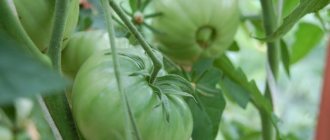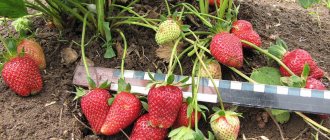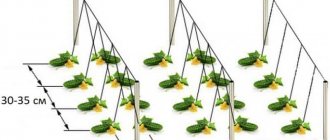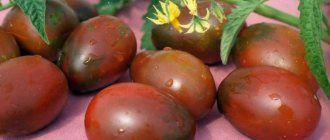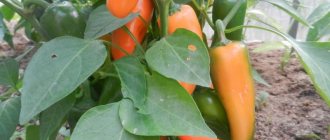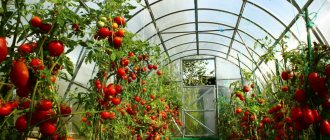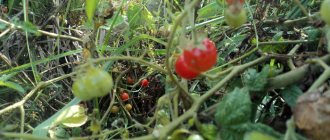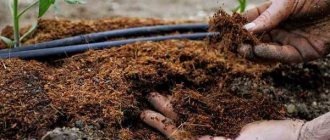When to plant tomatoes
The formation of the first stepsons on tomatoes is observed already at the stage of seedling development. In this regard, when planting seedlings in a greenhouse, they immediately remove all unnecessary shoots, the length of which at this time can reach only about 10 mm. Although this is quite hard work, such bushes will be much easier to care for at first.
After the seedlings planted in the greenhouse take root and begin to grow, they will begin to actively form stepchildren. You will have to systematically (about once every 1–1.5 weeks) inspect the tomatoes and cut off all excess shoots before they become too thick. Removal of stepchildren from greenhouse bushes is carried out regularly even after fruit harvesting begins.
Conclusions and wishes
We have found out with you how to plant tomatoes in a greenhouse, the step-by-step scheme of planting has been reviewed and I hope that now you will be able to perform this important work correctly.
But it should be noted that there are always different points of view regarding the formation of tomatoes.
Some gardeners suggest leaving not the stepson located in front of the first flower cluster, but the basal stepson. To do this, you need to cover it with earth and it will give its roots. Essentially, in this case, we seem to plant another bush next to the main one.
I can’t judge how justified this is, but you can experiment by doing this with several bushes.
It should also be noted that pinching tomatoes needs to be done repeatedly, about once a week.
Particularly relevant is pinching tomatoes in regions with relatively short summers. Bushes that are too thick begin to bear fruit later and the tomatoes do not have time to ripen on the vine. This applies primarily to Altai and Siberia.
And the last thing I would like to say: stepchildren is not just the removal of stepchildren, it is not clear why. This is, first of all, the correct formation of tomatoes, on which their yield will largely depend. Therefore, there is no need to treat this important matter as something secondary.
Best regards, Alexander Tkachenko.
Stepping technology
It is necessary to start pinching tomatoes growing in a greenhouse when the unnecessary shoots are still very thin and small. Make sure that they do not grow longer than 50 mm, because otherwise they will have time to take quite a lot of energy from the bush.
You should also remember that the thicker and longer the stepson, the more difficult it is to tear it off without injuring the stem, and this can cause the bush to be damaged by various diseases. That is why experienced gardeners recommend systematically inspecting plantings and removing stepsons immediately after they appear.
Rules and features of stepsoning:
- The pinching procedure is carried out in the morning, and the greenhouse should be well lit by the sun, and at this time it should be opened for ventilation. It is best to carry out this procedure on a warm, sunny day.
- The stepsons are removed first from the most powerful and healthy bushes, and the weakest tomatoes are left for last.
- It is extremely undesirable to use any tool, even a very sharp one, to remove stepchildren, as this can cause the spread of a viral disease from bush to bush.
- Remove the stepsons by hand. To do this, grab a young unnecessary shoot from above with two fingers and pinch it.
- In the place where the stepson was, there should remain a stump, which reaches a length of about 30 mm. In the future, where there is such a stump, a new shoot will not grow.
- When cutting off the stepson, do not pull it down under any circumstances. In this case, you can greatly harm the bush, stripping part of the stem along with the unnecessary shoot.
Types of pinching
There are several types of pinching, which differ in the amount left during the removal of excess shoots and branches. Each of these types has its own characteristics, which will be discussed in more detail below.
In one stem
The method of forming into one stem is excellent for bushes grown in a greenhouse. In this case, there will be no extra branches thickening the plants, which will provide them with good ventilation and sufficient light.
Immediately after the stepson begins to grow under the first formed brush, it should be cut off. At the same time, the lower leaf plates are also torn off from the bushes, which only hinder them at this stage of development. Next, carry out a systematic inspection of the bushes and cut off all emerging side shoots, while flowering brushes must be left behind.
Thanks to this method of forming a bush, about 50 brushes can grow on it, on which fruits will form. This method also allows you to extend the fruiting period.
In two stems
Forming a bush into two stems is also well suited for greenhouse tomatoes. In this case, you need to leave only one most powerful stepson, which grew under the first flowering brush. Those side shoots, as well as leaf plates that are located below this stepson, must be torn off. In the future, systematically inspect the bushes and cut off all excess shoots.
Three stems
Bushes formed into three stems are most suitable for growing in open ground, but not for a greenhouse. To form a plant into three stems, you need to cut off all the side shoots except two. The first stepson should be under the first flowering brush, and the second one should be above it. Next, the tomatoes are regularly inspected and excess shoots are removed.
Difference between a side shoot and a peduncle
IMPORTANT . You need to know the difference between a stepson and a peduncle. The first grows from the axil between the leaf blade, the main trunk. The beginning of useful formations occurs on the trunk.
Even the smallest stepsons have leaves. There are only flower buds on the fruit bearing.
Stepson of tomato
How to properly form tomatoes in a greenhouse
All varieties of tomatoes are divided into three types:
- indeterminate - bush growth continues throughout the entire growing season;
- semi-determinant - the bush can stop growing at any time, or it can continue to grow;
- determinant - completion of bush growth occurs after it has formed 4 or 5 flowering brushes.
Indeterminate varieties
If your greenhouse is small, then it is recommended to form tomatoes belonging to indeterminate varieties into one stem. If space allows, then to increase the yield the bushes can be formed into two stems. However, in this case, when planting bushes in a greenhouse, the distance between them should be quite large, which will allow the tomato to receive a sufficient amount of light as it grows.
In order to form a tomato into two stems, you need to leave its stepson, which grew under the first flowering brush. Only 4 or 5 flowering clusters are left on the second stem, and all the rest are removed.
Determinate varieties
In some cases, tomato bushes of determinate varieties do not germinate at all. As a rule, this procedure is resorted to only if they want to get an early harvest. To do this, tomatoes are formed into one stem.
There should be a maximum of four flowering brushes left on it, and all the rest should be cut off along with the side shoots. Above the highest inflorescence, you need to leave several leaf plates and pinch the top growth point of the bush. Thanks to this formation of the bush, the harvest can be obtained half a month earlier.
Semi-determinate varieties
It is impossible to predict whether a bush belonging to a semi-determinate variety will stop growing after it has formed several inflorescences or will continue to grow actively. That is why it is necessary to form a second spare stem on such a tomato. If the main stem stops growing, the fruits will form on the spare stem.
If the growth of the main stem does not complete after 6 to 8 inflorescences form on it, then, if desired, the second stem can be carefully torn off so that it does not take away the strength of the plant.
Formation of low-growing varieties
These so-called standard varieties are distinguished by the following features:
- their cultivation requires little effort and minimal costs;
- plant height reaches a maximum of 50 cm;
- no garter or support is needed;
- It is not necessary to plant undersized tomatoes;
- Such varieties can be successfully grown in a garden bed, in a greenhouse, or as a houseplant.
Low-growing tomatoes produce a harvest very early, their stems are fleshy and strong, so these tomatoes are grown without pinching. 3-5 fruiting clusters are formed on a short stem. The most popular are the following low-growing varieties:
- Gavroche;
- Alpha;
- Antoshka;
- Brawler;
- Far North.
Planting tomato bushes in a greenhouse is a simple and mandatory procedure aimed at providing better light conditions, ventilation of the bushes and the formation of a decent harvest. Excessive growth of green mass prevents fruits from accessing light, sufficient ventilation and water, which leads to reduced yields and the occurrence of diseases.
Caring for tomatoes in a greenhouse
When growing tomatoes in a greenhouse, special attention should be paid to watering. When the seedlings are just planted in the soil, they should be watered abundantly so that the soil is saturated to a depth of 20 to 25 centimeters. If at this time the young bushes do not receive the required amount of moisture, then they will take root and develop very slowly.
After the surface of the soil near the bushes dries slightly, it should be loosened. This procedure is carried out after each watering, since the crust that forms on the surface of the soil does not allow sufficient oxygen to penetrate to the roots.
The tomatoes are watered the second time only after 7 days have passed after planting them in the greenhouse. During this time, they must have time to take root and adapt to new conditions. The frequency of subsequent waterings is affected by the drying rate of the top layer of soil. On average, tomatoes are watered once every 5 days, with 4 to 5 liters of water taken per 1 square meter of plot.
Also, tomatoes grown in a greenhouse must be fed correctly and in a timely manner. Before planting seedlings in the soil, it should be prepared. To do this, add 1 tbsp. l. potassium sulfate, 2 tbsp. l. superphosphate and 5 liters of coarse sand per 1 square meter of bed. After the ground has been dug up, you can make holes and plant seedlings.
The tomatoes are fed the second time 3 weeks after planting. To do this, you can use mineral fertilizers or organic matter. The next time, feed the plants after a week and a half and use a complex mineral fertilizer for this, for example, Fertility or Ideal.
If desired, tomatoes can be fed a third time 12 days after the second feeding. This time it is recommended to use special preparations that improve the ovary of tomatoes, or you can add the following nutrient mixture to the soil: 1 bucket of water mixed with 1 tbsp. l. superphosphate and with 2 tbsp. l. wood ash. To feed bushes that have begun to actively bear fruit, use nitrophoska and sodium humate.
Feeding tomatoes in a greenhouse to increase the ovary - video
What is pinching?
Pinching tomatoes
This is the removal of the top of the tomato plant, its growing point. The procedure is especially important for tall crops.
Goals:
- Stop the growth of the bush so that the forces are directed towards obtaining a good harvest
- Strengthen the root system
- Improve the quality of tomatoes
- Accelerate ripening
- Ensure good lighting, ventilation, and complete supply of minerals to the fruits
- Avoid getting misshapen vegetables
The average pinching period is the end of July, until August 4.
Mistakes gardeners make when planting
Sometimes, when removing shoots from tomato bushes growing in a greenhouse, gardeners make serious mistakes that can cause the plants to become infected with infectious diseases or yield loss. Common mistakes:
- Untimely stepsoning. Excess side shoots must be removed systematically and in a timely manner. If you carry out such a procedure once a month or even less often, then it will be of little use. The fact is that long and thick stepsons will already have time to take away a significant part of the bush’s strength.
- Pruning not the stepsons, but the fruit branches. Often, inexperienced gardeners confuse these shoots. Carefully inspect the location where the shoot grows. If it does not grow from the leaf axil, but directly from the stem, then it is a fruiting branch and does not need to be cut off.
- Dirty tools. Experienced gardeners recommend removing stepchildren by hand. But if you use scissors for this, then be sure to disinfect them after trimming each bush. To do this, it is recommended to wipe them with any disinfectant solution, for example, a solution of potassium manganese. If this is not done, then from one diseased bush the infection can be spread to all bushes. If you tear off unnecessary shoots with your fingers, then make sure that tomato juice does not get on them, since it can also spread the infection.
- Applying too much fertilizer. If the bush has already been formed, but stepsons are still actively growing in its lower part, this means that too much fertilizer is being added to the soil. In order to correct the situation, stop feeding for a while or adjust their regimen and dosage.
Why do this work?
Stepsoning means removing unnecessary shoots (stepchildren) emerging from the axils of tomato leaves.
Removing a side shoot manually
Productivity depends more on the availability of light and nutrients than on the number of flowers and stems.
The appearance of the ovary and its maturation occur with good lighting and air exchange. If you do not cut off the useless shoots, the minerals will go to the growth of green mass, and the tomatoes will be tasteless and small.
